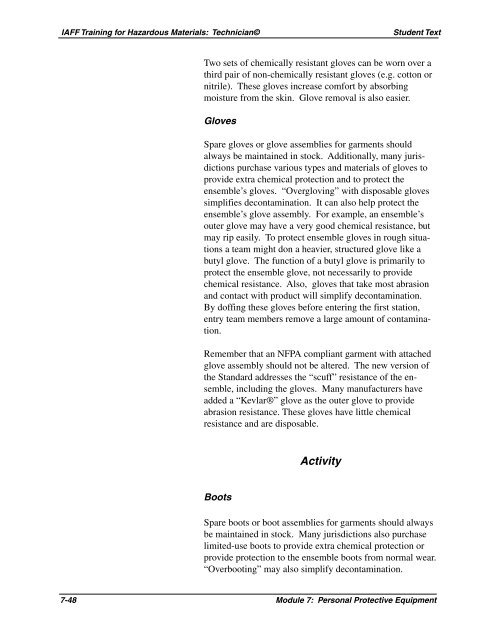Module 7 - IAFF
Module 7 - IAFF
Module 7 - IAFF
You also want an ePaper? Increase the reach of your titles
YUMPU automatically turns print PDFs into web optimized ePapers that Google loves.
<strong>IAFF</strong> Training for Hazardous Materials: Technician©<br />
Student Text<br />
Two sets of chemically resistant gloves can be worn over a<br />
third pair of non-chemically resistant gloves (e.g. cotton or<br />
nitrile). These gloves increase comfort by absorbing<br />
moisture from the skin. Glove removal is also easier.<br />
Gloves<br />
Spare gloves or glove assemblies for garments should<br />
always be maintained in stock. Additionally, many jurisdictions<br />
purchase various types and materials of gloves to<br />
provide extra chemical protection and to protect the<br />
ensemble’s gloves. “Overgloving” with disposable gloves<br />
simplifies decontamination. It can also help protect the<br />
ensemble’s glove assembly. For example, an ensemble’s<br />
outer glove may have a very good chemical resistance, but<br />
may rip easily. To protect ensemble gloves in rough situations<br />
a team might don a heavier, structured glove like a<br />
butyl glove. The function of a butyl glove is primarily to<br />
protect the ensemble glove, not necessarily to provide<br />
chemical resistance. Also, gloves that take most abrasion<br />
and contact with product will simplify decontamination.<br />
By doffing these gloves before entering the first station,<br />
entry team members remove a large amount of contamination.<br />
Remember that an NFPA compliant garment with attached<br />
glove assembly should not be altered. The new version of<br />
the Standard addresses the “scuff” resistance of the ensemble,<br />
including the gloves. Many manufacturers have<br />
added a “Kevlar®” glove as the outer glove to provide<br />
abrasion resistance. These gloves have little chemical<br />
resistance and are disposable.<br />
Activity<br />
Boots<br />
Spare boots or boot assemblies for garments should always<br />
be maintained in stock. Many jurisdictions also purchase<br />
limited-use boots to provide extra chemical protection or<br />
provide protection to the ensemble boots from normal wear.<br />
“Overbooting” may also simplify decontamination.<br />
7-48 <strong>Module</strong> 7: Personal Protective Equipment
















